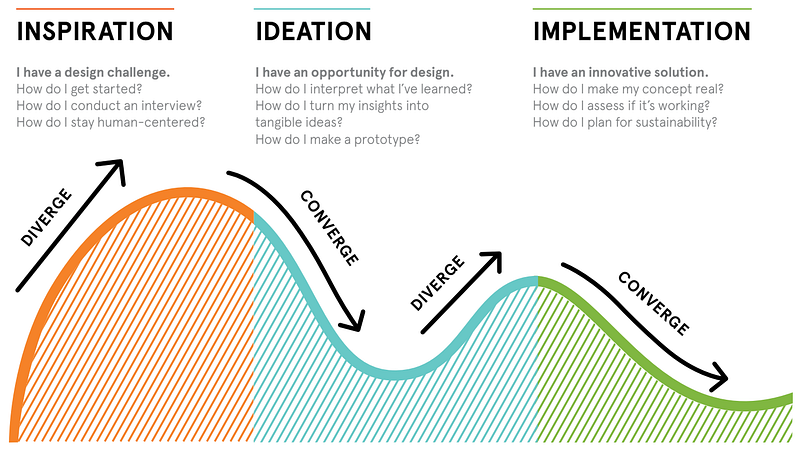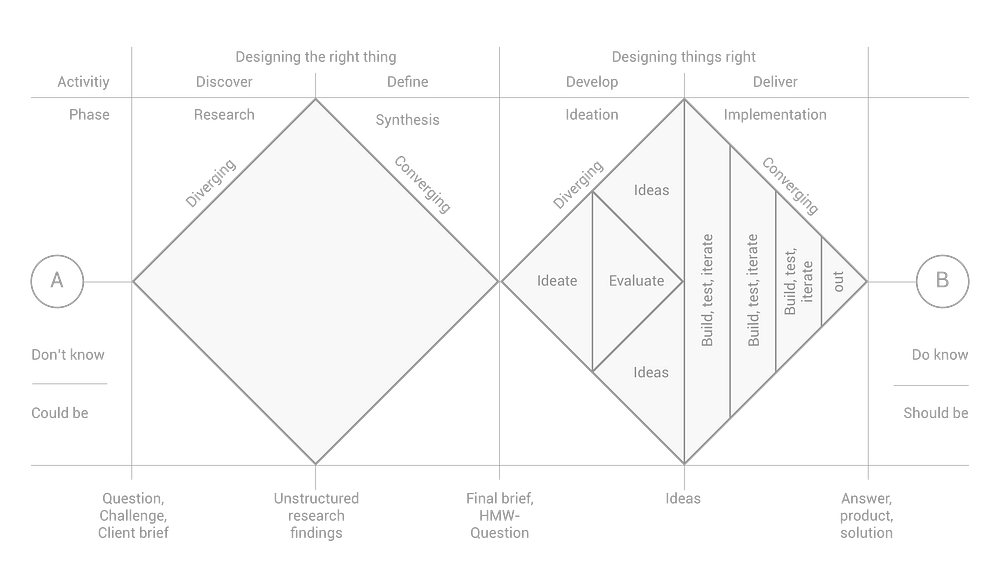How to apply a design thinking, HCD, UX or any creative process from scratch

This how-to article aims at providing designers, creative thinkers or even project managers with a tool to set up, frame, organise, structure, run or manage design challenges, and projects: The Double Diamond revamped.
The Double Diamond revamped
In order to do so, I have come up with an own and a revamped version of the Double Diamond process. In case, you are familiar with the British Design Council’s Double Diamond, IDEO’s human centred design ideology or @d.school’s Design Thinking process you might be familiar with the majority of approaches, steps and tools in the following paragraphs of this article.



Understanding people
According to Don Norman, the human centred design process starts with a good understanding of people and the needs that the design is intended to meet. Various companies, organisations and educational institutions have taken on this challenge and have therefore come up with models in order to provide structure to the process of human centred design or design thinking.
Chilli Con Carne and the Double Diamond
When you cook a chilli con carne for the first time, you might start off with a recipe that appeals to you. Once you have burned your tongue a couple of times, you either go easy on the spices, or you even spice it up as you can’t get enough of the burning. Generally speaking, you tweak the original recipe to your own needs and taste.
…tweak the original recipe to your own needs and taste…
That’s what I have done to the design process during my previous months trying to master Digital Experience Design at Hyper Island.
As a starting point for my dish, I am using the Double Diamond process, originally released by the British Design Council. I like this framework for its structure, clarity and dynamic.
Point of departure and basics
The core question in almost any creative or design project is how to get from point A – “Don’t know” or “Could be” – to point B – “Do know” or “Should be”. This process might seem finite and straightforward at first sight.
In reality, it is a never ending process, as creativity is the habit of continually doing things in new ways to make a positive difference to our life (Hyper Island, 2016).
…creativity is the habit of continually doing things in new ways to make a positive difference to our life (Hyper Island, 2016).
The Double Diamond is a structured design approach to tackle challenges in four phases:
- Discover /Research— insight into the problem (diverging)
- Define/Synthesis — the area to focus upon (converging)
- Develop/ Ideation— potential solutions (diverging)
- Deliver /Implementation— solutions that work (converging)
Phases of this process are either diverging or converging. During a diverging phase, you try to open up as much as possible without limiting yourself, whereas a converging phase focuses on condensing and narrowing your findings or ideas.
If you google the Double Diamond you are bound to find various interpretations and also varying wordings. I am going to stick to the version above as its wording allows flexibility and agility in its application in my opinion. Or in other words, it is the most appealing recipe to me.
The four phases of the Double Diamond may be simplified and merged into two main stages of the process.
- Stage 1 — Doing the right thing (Diamond 1 — Discover and Define)
Whatever you do, you ought to look for the right problem to solve or the right question to ask before you try to do so. This is all about what you do. - Stage 2 — Doing things right (Diamond 2 — Develop and Deliver)
Once you have found the right question to answer or the right problem to solve, you want to make sure that you do this the right way. This is all about how you do it.

The following paragraphs provide you with a step-to-step approach for each phase.
Stage 1 — Doing the right thing (Diamond 1 — Discover and Define)
This phase is split into Discover/Research and Define/Synthesis.
Discover / Research
- Rip the brief (the usual starting point of your challenge) — Try to question the brief or your initial question by challenging every part of it and evaluating fields of interests.
List as many elements as you can, find characteristics, define areas of interest and extremes, list places, people (personas), experiences that are related and can be explored. - Before you dive into your research, cluster your findings into topics to get an overview and you might have to limit yourself in terms of the scope you want to research.
- Dive into your research. Apply primary (field) and secondary (desk) research methods. Here is an extensive list of research methods by ideo.org.
As a result, you ought to end up with a huge pile of unstructured research findings.
Define / Synthesis
In order to make sense of your findings, you want to synthesise your research by applying the following steps:
- Download (summarise your raw findings and share them with your team) all your research.
- Cluster learnings and similarities to themes.
- Find insights (insights are the dormant truth about the consumer’s motivations, wishes or frustrations regarding a specific topic)
build opportunity areas (a phrasing of the potential area of action). - Create HMW questions (A so called “how might we…” question that makes a tangible statement of what is to be done or solved within the area of action).

As a result, you ought to come up with a revamped brief (final brief, HMW-question) that either clarifies or details the initial brief challenge or even contradicts it.
Stage 2 — Doing things right (Diamond 2 — Develop and Deliver)
This phase is split into Develop/Ideation and Deliver/Implementation.
Develop / Ideation
As you have deduced the actual question to solve or challenge, you start ideating.
- Ideation
This is the fun part and as it is part of a diverging phase. You should restrain from limiting yourself and approach ideation with an open mind. Do not judge during ideation. Apply a “yes, and…” rather than a “no…” or “yes, but…” mentality. Let anything happen at this point and build upon each other’s ideas. There are tonnes of creative ideation tools and methods out there. I am not going into detail here. - Evaluation
Towards the end of an ideation phase, evaluate your ideas and select your favourite ones. Two tools you that come in handy are dot-votings (each team member votes for ideas) or impact/feasibility matrixes (a matrix that puts feasibility in relation to a potential impact of an idea).
As a result, you ought to end up with one or a small number of ideas you want to later prototype and test, in order to find the best answer or solution to your initial question or problem.
Deliver / Implementation
Once you have come up with potential solutions (set of ideas), you want to evaluate the final one and the way it needs to be implemented or executed. In order to so, you may apply an agile approach consisting of three steps:
- Build/Prototype
- Test/Analyse
- Iterate/Repeat
Aim for MVPs — minimum viable products/prototypes, that offer enough tangibility to find out whether they solve the initial problem or answers the initial question.
As a result, you ought to be able to go “out” with your final proposal, product, answer or solution.

Once you have done so you might go back to start and do it all over again because there are always things to be improved.
Remember: Creativity is the habit of continually doing things in new ways to make a positive difference to our life (Hyper Island, 2016).
One more… wait… two, three more things
This article or guide is by no means concluding and doesn’t claim to be the one and only approach or way to do it.
This revamped Double Diamond is just ONE and my personal approach. It’s not the ONE AND ONLY approach and it is here to be challenged, questioned and iterated upon.

Depending on your role and a project, the size of the diamonds may also vary. Meaning that there might be challenges or projects, in which you solely focus or emphasis on one part of the Double Diamond. Furthermore, this process is not linear. In reality, you need to be prepared to be agile and go back and forth at any point.
This article also focuses on the general structure of the process rather than all the individual tools and methods that may be applied to it.
In the end, it is a framework anyone may or may not apply. It has helped me and guided me through the design process.
Nevertheless and at some point you will be stuck in the fog, and you will feel lost in the process. It’s normal, deal with it and trust the process.
By Dan Nessler


